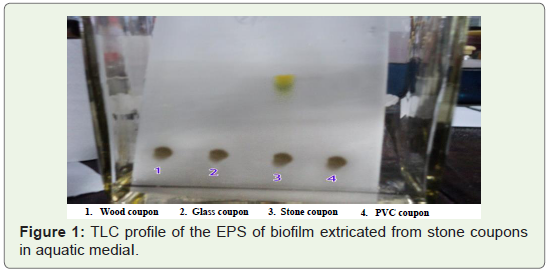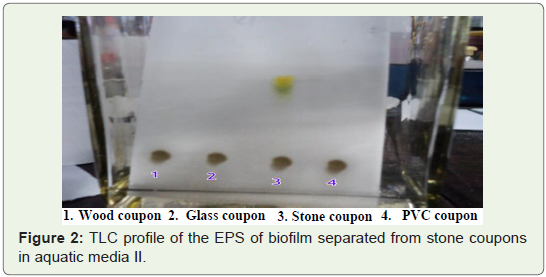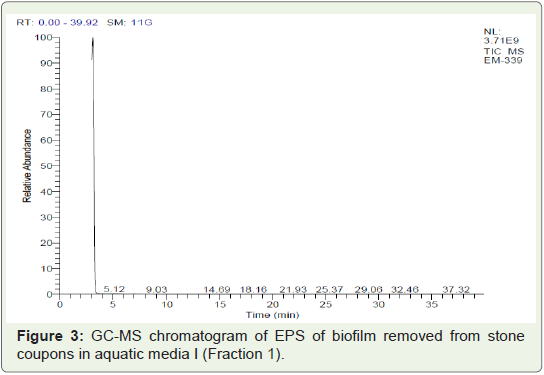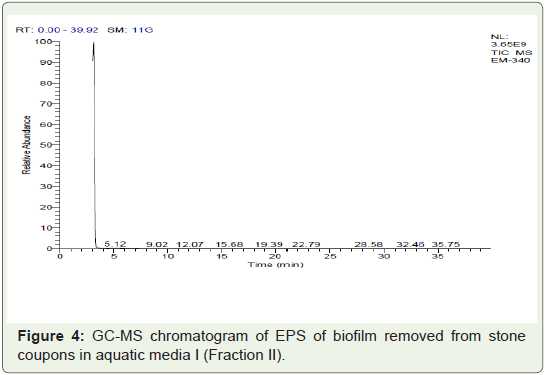Research Article
Identification of Bioactive Mixtures from Biofilm EPS Separates Utilizing Various Coupons in Two Aquatic Media
Uma Rajeswari S1* and Selva Raj D2
1Department of Zoology and Research centre, Pasumpon Muthuramalinga Thevar college, India.
2Department of Zoology and Research Centre, Scott Christian College (Autonomous), India
*Corresponding author: Uma Rajeswari S, Department of Zoology and Research centre, Pasumpon Muthuramalinga
Thevar College, Melaneelithanallur, Tamilnadu, India. Tel: 7373503579, Email: umarajeswari20@gmail.com
Copyright: © Uma Rajeswari S, et al. 2021. This is an open access article distributed under the Creative Commons Attribution
License, which permits unrestricted use, distribution, and reproduction in any medium, provided the original work is properly cited.
Article Information: Submission: 02/04/2021; Accepted: 05/05/2021; Published: 08/05/2021
Keywords
EPS; Bioactive; Coupons; Compounds
Introduction
Bioactive mixtures are normal items and these synthetic
mixtures possess a significant specialty in drug disclosure and plan.
Microorganisms have demonstrated to be a beneficial wellspring of
lead structures for the improvement of new antimicrobial specialists.
Microorganisms and their secludes address a significant wellspring
of unseen logical potential. The quantity of microbial life forms
disengaged from the immense sea domains keeps on expanding
every year. Hence, characteristic items isolated from microorganisms
hinder conditions other than soil are an appealing examination
device, for natural chemists and microbiologists, yet in addition for
pharmacologists and clinicians. Microorganisms and their bioactive mixtures has thusly become a significant assignment in the quest for
novel drugs.
The auxiliary metabolites, delivered by specific microbes, growths
and green growth may have some level of bioactivity, either against
another microorganism or acting against certain physiological
conditions of an unhealthy body. A portion of these mixtures can show
bactericidal or bacteriostatic exercises and are presently oftentimes
utilized in clinical settings as anti-toxins to treat bacterial diseases.
Nonetheless, microbes have advanced various methodologies to
detect, react and adjust to these little substance compounds [1-3].
Bioactive mixtures are normal items and these synthetic
mixtures possess a significant specialty in drug disclosure and plan. Microorganisms have demonstrated to be a beneficial wellspring of
lead structures for the improvement of new antimicrobial specialists.
Microorganisms and their secludes address a significant wellspring
of unseen logical potential. The quantity of microbial life forms
disengaged from the immense sea domains keeps on expanding
every year. Hence, characteristic items isolated from microorganisms
hinder conditions other than soil are an appealing examination
device, for natural chemists and microbiologists, yet in addition for
pharmacologists and clinicians. Microorganisms and their bioactive
mixtures has thusly become a significant assignment in the quest for
novel drugs.
The auxiliary metabolites, delivered by specific microbes, growths
and green growth may have some level of bioactivity, either against
another microorganism or acting against certain physiological
conditions of an unhealthy body. A portion of these mixtures can show
bactericidal or bacteriostatic exercises and are presently oftentimes
utilized in clinical settings as anti-toxins to treat bacterial diseases.
Nonetheless, microbes have advanced various methodologies to
detect, react and adjust to this little substance [1-3].
Chromatography is a logical strategy that is broadly utilized for
the detachment, disengagement, Identification and measurement of
bioactive mixtures in a combination. Thin layer chromatography,
(TLC) generally utilized in characteristic item separate investigation,
steadiness trial of concentrates and completed items and in example
quality control [4] is a delicate method, even microgram (0.000001 g)
amounts can be examined by TLC and it requires some investment
for an examination (around 5-10 mins). Gas Chromatography Mass
Spectrometry (GC-MS) is an instrumental procedure, including
a gas chromatography coupled to a mass spectrometer, by which
complex combinations of synthetics might be isolated, recognized
and evaluated. This makes it ideal for the investigation of the many
moderately low atomic weight intensifies found in characteristic
materials. Utilization of GC-MS incorporates drug location, fire
examination, natural examination, explosives examination and ID
of obscure examples. In the current investigation was completed to
isolate and distinguish bioactive mixtures found in the TLC divisions
with the assistance of GC-MS and NIST library.
Materials and Methods
Development of EPS in various coupons:
The examinations were directed in six fiber tanks (limit 100 L).
There were two analyses each had three replications. The cowdung
excrement were gathered from nearby dairy homestead and permitted
to deteriorate for 10 days preceding application. In the primary test
(aquatic media I-pond water) no fertilizer was added. In the second
analysis 2 Kg cowdung fertilizer was included 100 liter water (aquatic
media II-cowdung improved pond water). Four diverse test coupons
like stone (7×7 cm), wood (6.7×6.7 cm), glass (6×6 cm), and PVC pipe
(7×4 cm) were fitted in a wooden casing and inundated in the two test
set up. Before drenching the coupons were washed completely, dried
and flushed with 70% liquor (Rao, 2003) [5]. Test coupons (wood,
stone, glass, and PVC) were recovered every week over a time of 35
days.Partition of EPS segments by Thin Layer Chromatography:
30gms of silica gel ‘G’ was gauged and made to a homogenous
suspension with 60 ml refined water for two mins. The interference
was diffuse preposterous which was air dried until the lucidity of the
layer scatter. The plates were dried in hot air stove at 110°C for 30 mins
and afterward put away in a dry climate and utilized at whatever point
required. EPS concentrate of biofilm developed on various coupons
were taken in slim cylinders and were spotted on a TLC plate 2cm
over its base. After the utilization of the example on the adsorbent,
the TLC plate was kept in the dissolvable in TLC glass chamber and
permitted the portable stage (20 ml benzene, 20 ml acidic corrosive
and 60 ml ethanol) to travel through adsorbent stage up to 3/fourth of
the plate. The partition happened and the shaded spots were noticed.
The created TLC plates were air dried and presented to Iodine fumes
by setting in a chamber that was immersed with iodine fumes [6].
All plates were pictured straight forwardly, subsequent to drying the
Rf estimation of the various spots that were isolated was determined.
The dried spots were re-disintegrated in ethanol for the resulting
investigation by GC-MS.GC-MS investigation of EPS Extract:
2 μl of the TLC parts of the EPS was utilized for GC-MS
investigation. Every TLC parts acquired from various coupons
drenched in two distinctive oceanic media were independently
analyzed utilizing Shimadzu GC-MS-QP 5050 A GC hardware.
Programming Class 5000 was utilized. The LIB Column utilized was
DB 5 with 0.53 mm ID and standard planning of 30 m on a 1.5μm
film. The ionization mode was set at EL (70ev). The temperature was
modified to be at 400c (static for 2 min) up to 250ºc (static for 7.5
min). Both the indicator and injector temperatures were kept up at
250ºc.Synthetic mixtures isolated from TLC parts of concentrate
through GC-MS was recognized by utilizing library looked through
information base Wiley 229 LIB and by contrasting their maintenance
records and mass fracture designs with those of the accessible
references and with distributed information. The rate synthesis of
segments of the volatiles was controlled by automated pinnacle
territory estimations.
Results
Of the four distinct coupons utilized for biofilm detailing, TLC
spots were noticed uniquely in the EPS remove gathered from stone
coupons inundated in both the aquatic media. The TLC example of
the EPS extricate from stone coupons inundated in aquatic media I
showed 2 spots with the Rf estimation of 0.73 and 0.78 individually.
The EPS of biofilm isolated from stone coupons in aquatic media II
showed a solitary spot with Rf esteem 0.52. No spots were found with
EPS extricated of biofilm got from PVC, glass and wood coupons.
The GC-MS of division I of EPS extricated from stone coupons in
aquatic media I uncovered the presence of 9 pinnacles demonstrating
nine mixtures (Figure 1, Table 1). The significant pinnacle
demonstrated the presence of Hexadecane at the maintenance season of 5.12 min and the more modest pinnacle showed 2-Ethylhexyl
ester butanoic corrosive with the maintenance season of 9.03 min.
The other seven compound, demonstrated with the NIST range
are 3-Cyclopropylidene-1-(tri methyl silyl)- 1-Propyne, Ethyl
1,8-Diiodo-3,6-di (tert-butyl) fluorine - 9-Yl Acetate (RT. 18.14
min), Nonanoic corrosive methyl ester (RT. 21.93 min), hostile to
5-(1-hydroxyundecyl)- 3-(3-methyl butyl) oxazolidin-2-one (RT.
32.46 min), 1,2,5,6 - Di-O isopropylidene - a, D-allofuranose-R-1-
phenyl however 3-ene-1-sulfonate (RT. 37.32 min) and (Z)- 2-Fluoro-
2-butene (RT. 39.45 min) individually.
Table 1: Bioactive mixtures distinguished in the EPS extricate (Fraction I) of biofilm developed for stone coupons in aquatic media I
GC-MS example of division II of EPS extricate showed the presence
of nine pinnacles (Figure 2 and Table 2). The main pinnacle address
Octacosane with the maintenance season of 5.12 min. Tritetracotane
was recognized at the maintenance season of 9.02 min. Maintenance
time 11.83 min uncovered the presence of Propanedinitrile,
Methylene. Tricosane was recorded at the maintenance season of
15.68 min. At the maintenance season of 19.39 min the compound
noticed was 1, 5-Dicholoro-9, 10-bis (P-diphenyl) anthracene. 1,
2-Benzene dicarboxylic corrosive, (bis 2-methyl propyl) ester was
the conceivable compound at the maintenance season of 21.02 min.
5-Hexen-3-one was recognized at the maintenance season of 26.65
min. The top at the maintenance season of 32.46 min demonstrates
1, 2-Benzene dicarboxylic corrosive disoctylester as the conceivable
compound. 1-Undecen-4 - ol was the distinguished compound at the
maintenance season of 35.55 min.
Table 2: Bioactive mixtures distinguished in the EPS remove (fraction 2) of biofilm developed for stone coupons in aquatic media I
GC-MS chromatogram of the stone coupon of aquatic media
II uncovered the presence of eight pinnacles addressing eight
bioactive mixtures (Table 3, Figure 3,4). The significant pinnacle
showed, the compound 10, 11-Dihydro - 7, 8-(methylenedioxy) -
13H-pyrido (4’3’:3,4) pyrrolo (2,1-b)(3) benzazepin-13-one at the
maintenance time 30.74 min. The second biggest pinnacle showed the presence of 1-(2-(3, 4-dimethoxyphenyl) ethyl) - 2-Quinol with
the maintenance season of 35.56 min. The top at the maintenance
season of 30.74 min uncovered the presence of 10,11-Dihydro-
7,8-(methylenedioxy) - 13H-pyrido (4’3’:3,4) pyrrolo (2,1-b) (3)
benzazepin - 13-one and 1-Dotriacontanol with the maintenance
season of 21.02 min, 1-Tetradecanol was the conceivable compound
addressing the pinnacle recorded at the maintenance season of 17.26
min. The compound 1-octadecanol saw at the maintenance season of
13.80 min. 1-Hexadecane was recorded with the maintenance season
of 10.62 min and Cyclohexane hexyl at the maintenance season
of 7.20 min. Styrene was the conceivable compound seen with at
maintenance season of 3.86 min.
Figure 3: GC-MS chromatogram of EPS of biofilm removed from stone
coupons in aquatic media I (Fraction 1).
Figure 4: GC-MS chromatogram of EPS of biofilm removed from stone
coupons in aquatic media I (Fraction II).
Discussion and Conclusion
Bioactive mixtures blended by microorganisms comprise of lowsub-
atomic weight substances vital for the endurance of the creating
living being [7]. Attention profile of EPS remove gathered from
various coupons uncovered that, two unmistakable pieces are created
in the EPS of stone coupon from aquatic medium I and just one
section was seen in the EPS of stone coupon from aquatic medium
II. EPS extricate from different coupons didn’t show any conspicuous
spots. This might be because of the presence of extensively higher
grouping of bioactive atoms in the EPS of stone coupons than
different coupons [8] announced that stone coupons with unpleasant surface kindnesses connection of microorganisms and ensuing EPS
creation.
In the current investigation, GC-MS examination of division
I of the EPS remove from stone coupon of aquatic I uncovered the
presence of 9 mixtures. Among them Hexadecane (RT-5.12 min)
is the significant compound. Hexadecane is an alkane hydrocarbon
with the substance recipe C16H34. Hexadecane is utilized to quantify
the explosion of diesel fuel. [9] assessed the antimicrobial and cell
reinforcement impact of hexadecane. The discoveries of the current
examination connected with these discoveries and recommend
that positive job of hexadecane in the antibacterial action of stone
coupons EPS remove.
The subsequent significant compound is 2-Ethylhexyl ester
butanoic acid (RT-9.03 min). It is a carboxylic corrosive with the
primary equation CH3CH2CH2-CO2H. Butanoic corrosive is found
in goat, sheep and bison milk, spread and as a result of anaerobic
aging. The role of 2-Ethylhexyl ester butanoic corrosive contrasts
among typical and destructive cells. This is known as the “butyrate oddity”. Butyrate hinders colonic tumor cells, and advances sound
colonic epithelial cells [10] however the flagging component isn’t
surely known. The creation of unstable unsaturated fats, for example,
butyrate from fermentable filaments may add to the part of dietary
fiber in colon malignant growth treatment [11].
The compound Nonanoic corrosive methyl ester is an unsaturated
fat. It is a natural compound made out of nine carbon molecules
ending with a carboxylic corrosive. It is regularly utilized related to
Glyphosate a non-particular herbicide, for a speedy torch impact
in the control of weeds in turfgrass. This compound is additionally
utilized in the investigation of plasticizers and finishes. The other
compound enemy of 5-(1-hydroxy undecyl)- 3-(3-methyl butyl)
oxazolidin-2-one (RT-32.46 min) is a hetrocyclic natural compound
containing both nitrogen and oxygen in a 5-membered ring. They are
primarily utilized as antimicrobials.
Oxazolidinones filling in as protein union inhibitors focusing
on an early advance including the limiting of N-for mylmethionyl-t
RNA to the ribosome accordingly displaying solid antimicrobial impact. The unmistakable antimicrobial movement showed by the
EPS remove got from stone coupons of the sea-going medium I in
the current investigation might be because of essence of hostile to
5-(1-hydroxy undecyl)- 3-(3-methyl butyl) oxazolidin-2-one. [12]
revealed the utilization of enantiomerically unadulterated oxazolidin-
2-one subordinate as a chiral helper in deviated aldol buildup. The
tremendous utility of this and related oxazolidinones has been
sufficiently shown by [13]. The compound (Z)- 2-Fluro-2-butene
(RT-39.45 min) is an alkane with the equation C4H8. They can be
utilized as a monomer for poly butane yet this polymer is more costly
than choices with more limited carbon chains like poly propylene.
In the current examination, 9 substance constituents have been
recognized in the IInd part of aquatic media I (Table 2). Among
the distinguished mixtures Octacosane (RT-5.12 min) is has a
place with the hydrocarbon group of direct alkanes with the atomic
recipe of C28H58. They structure the significant piece of diesel and
aeronautics fuel. The compound Propanedinitrile, methylene (RT-
11.8 min) is a nitrile with the equation CH2 (CN)2. It causes genuine
eye aggravation. It might cause a hypersensitive skin response. It is
extremely poisonous to amphibian life. The compound Tricosane
(RT-15.68 min) is the isomers of aliphatic hydrocarbon having 23
carbon molecules. [14] announced that it has faint smell of wax.
The compound 1, 5 - Dichloro-9, 10-bis (P-diphenyl) anthracene
(RT-19.39min) is a strong poly cyclic fragrant hydro carbon. It is
utilized in the creation of the red color alizarin and different colors.
It is utilized as an insect poison in wood additives insect sprays.
Mycobacterium sp. biofilms displayed direct contact of extracellular
polymeric substances (EPS) with the anthracene surface [15]. 1,
2-Benzenedicarboxylic corrosive, bis (2-methylpropyl) ester (RT-
21.02) is a natural compound. It is set up by esterification interaction
of isobutanol and phallic anhydride. It is utilized in nitrocellulose
plastic, nail clean and dangerous material. [16] likewise noted presence
of the 1, 2-Benzenedicarboxylic corrosive, bis (2-methylpropyl) from
biofilm EPS extricate. This ester is broadly utilized as plasticizers in
assembling PVC.
In the current examination, 8 mixtures were distinguished
from the oceanic media II. Styrene (RT-3.86 min) is a most straight
forward alkenyl benzene and it is an unsaturated fragrant monomer.
It is a FDA affirmed manufactured seasoning specialist and adjuvant
for frozen yogurt and candy [17]. Styrene is the second most plentiful
polymer delivered around the world. Notwithstanding polystyrene,
styrene monomers are additionally utilized in the assembling of
different items including styrene-acrylonitrile polymer, styrenebutadiene
elastic and various pitches and cements. It is utilized as in
the assembling of styrenated polyesters, elastic adjusted polystyrene
and copolymer gums, as a moderate and in the production of
defensive surface coatings, including styrene butadiene latex and
alkyds [18,19].
The compound Cyclohexane hexyl (RT-8.34 min) confined
from EPS concentrate of amphibian medium II is an organo
chlorine. They have been utilized both as a horticultural insect spray
and as a drug treatment for lice and scabies [20]. The compound
1-Octadecanol (RT-13.0) is agreasy liquor. It has a wide scope of employments as fixing in ointments, pitches, aromas and beauty
care products. It has additionally utilized as a vanishing smothering
monolayer when applied to the surface water. 1-Tetradecanol (RT-
17.26 min) is a straight-chain soaked greasy liquor, with the atomic
equation C14H30O. It is likewise utilized as a middle in the substance
combination of different items like sulfated liquor. The compound
1-(2-(3, 4-Dimethoxy phenyl) ethyl) - 2-Quinone (RT-35.54 min) is a
class of natural mixtures that are officially gotten from sweet-smelling
compounds. Normal or manufactured quinones show an organic or
pharmacological movement and some of them show antitumoral
action. They typify a few cases in natural medication. These
applications incorporate laxative (sennosdes), antimicrobacterial
(rhein-and saprorthoquinone), against tumor (emodin and jugone),
hindrance of PGE2 biosynthesis (arnebinone and arnebifuranone)
and hostile to cardiovascular sickness (tanshinone) [21] Quinones
play an important role in medicine. Due to their anti-oxidant effects,
they are also currently being investigated as part of the treatment of
head trauma [22] and neurological diseases like Parkinson disease
[23], Huntington disease [24] and Alzheimer disease [25]. Oxidative
stress appears when there is an disproportion between the production
and quenching of free radicals from oxygen species. The mitochondria
play a central role in the formation of excess reactive oxygen species.
Quinones can intention the mitochondria and re-establish electron
transfer in insufficiency states. On the other hand quinines are
involved in the induction of cancer and neurodegenerative disease
[26,27]. Quinone derivatives of estrogens, benzene, and dopamine
have been observed to exposure production of DNA adducts that
initiate mutations leading to cancer as well as neurodegenerative
diseases [26]. Plastoquinol, an anti-oxidant initiate in chloroplasts, is
being showed for its crisis in the suppressing of age-related pathologies
such as declining immunity, balding, cataracts and osteoporosis
[28]. Aging is associated with oxidative stress, thus quinones
have a potential role in modulating the process [29]. Moreover,
quinones are still being investigated for their ant malarial effect
[30,31] Bacillus subtilis that is utilized to analyze the machanisms
of Biofilm lattice creation and the resulting change from a motile
planktonic cell state to a sessile Biofilm state followed by [32-35].
[36-40] proposed and tried gelling properties of Octasaccharide were
acquired from Pseudoalteromonas. Likewise thickening specialist in
food contamination industry, biotoxification and squander water
treatment, bone recuperating treatment of cardiovascular illnesses
of uronic corrosive and pyruvate found from Alteromonas macleodi
[41-44]. Rinker and Kelly revealed the Biofilm arrangement of
monosaccharide were available from Thermococcuslitoralis. [45.46]
recommended that drug utilization of glucogalacto arrangement were
gotten from Geobacillus sp. [47-50] detailed immunomodulatory
and antiviral infections of manno-pyranosidic arrangement were
available in Bacillus thermodentrificans. From over all microscopic
organisms disengaged from biofim EPS created by microorganisms
segregated from aquatic conditions. The biofilm EPS interaction of
the different bacteria can yield a multitude of results and an endless
number of novel compounds. Biofilm EPS using stone coupons can
be used to produce different compounds by the combination of a
variety of bacteria.
References
37. Searls DB (2000) Marine bacteria as sources of new bioactive compounds. Drug Discovery Today 5:135.








